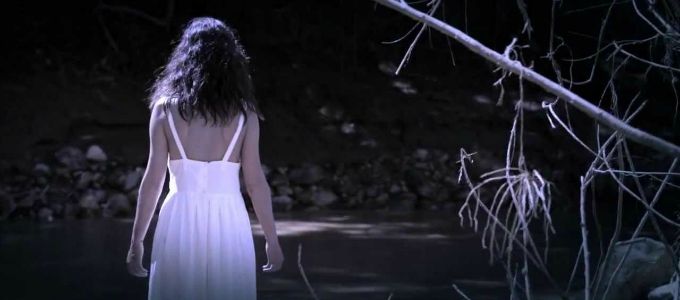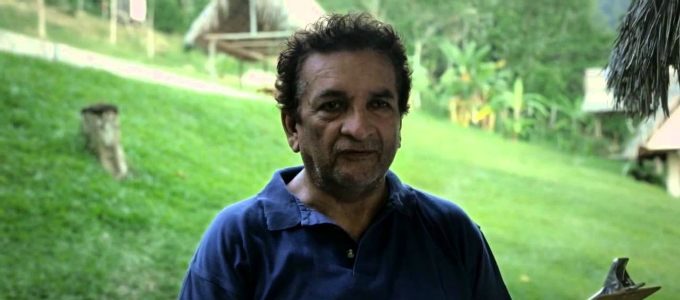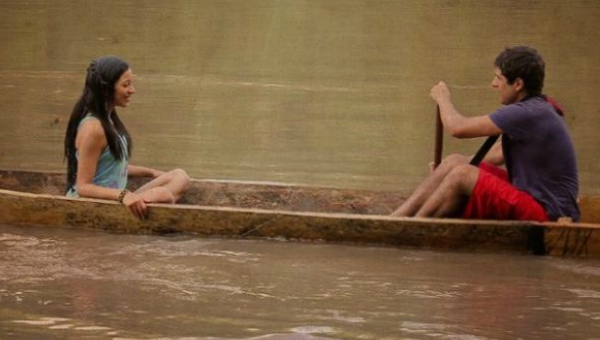
Choose LA CARA DEL DIABLO for some of the cosiest horror you will ever enjoy. Team this welcome Spanish slasher with knock-off Cookie Dough, friends you wouldn’t mind snogging, and your most insulated pyjamas. Whilst the film’s narrative and aesthetic foundations admittedly do more to open-heartedly espouse the conventions of the teen-horror genre than to push beyond them, there is something importantly likeable at work here, which is not something you can often say about tales of woodland bloodshed. Prepare to be unexpectedly seduced.
LA CARA DEL DIABLO follows the quiet, nervous Lucero as she goes on holiday into the Peruvian rainforest with her friends and boyfriend. Arriving at their lodge by boat, they discover – no surprises here – that they will be staying in entirely isolated accommodation, devoid of Wifi and phone signal, and complete with foreboding hotel manager and gruesome local myths. Before long, the group of friends excitedly learn of the legend of “el tunche”, a malevolent forest entity that picks off unsuspecting travellers in a variety of gruesome manners. When members of the group begin to disappear in mysterious and unsettling circumstances, the question of this folkloric creature’s presence becomes of very real concern. Demons from the characters’ troubled pasts are reawakened by the escalating terror of their immediate surroundings, and the randy teen getaway quickly becomes a slalom of survival as physical as it is psychological.
…threats and monsters undermine and pick holes in these glistening, heteronormative skins…
The film’s strength is undoubtedly indebted to its infectiously likeable cast. Our heroes are young, energetic, chaotic and vulnerable. They jump naked into lagoons, are lovably consumed by their burning teen loins – think swimming pool fantasies and latent queer desires – and look delighted at the possibility of all-day lunch. They have great piercings, and fantastic floppy wet hair. Their energy is both bawdy and nervous, and works perfectly as the central drive of a film itself so tangibly eager to wade openly into territory which will inevitably prove slightly too much to handle. Given the film’s decidedly traditional, minimalist approach to the choreographing of fear and suspense, the erratic vitality and youth of the cast provides something necessarily material to cling on to. Where the audience’s blood is left to freeze in response to simple sound effects, shot duration and lighting rather than any particularly inventive twists or visuals, the convincingly electrified bodies powering the narrative lend every jump a vitally human weight.
Whilst inhabiting common territory, the film nevertheless picks as its core matter an inexhaustibly subversive favourite of the genre: the seemingly robust, carefree teen body and its secret hauntings. Manifesting both internally and externally, threats and monsters undermine and pick holes (often quite literally) in these glistening, heteronormative skins, eroding socialised facades and detecting within all human desire strains of the inhuman and the murderous. The density of the forest serves as an ingenious setting for these undoings and transformations, hiding places for both personal and supernatural ills provided by an Edenic screen of greenery that holds open the question of what is and isn’t organic in human terror. This yoking together of fantastical and everyday horror allows for a non-hierarchical exploration of isolation and suffering through everything from forest ghouls to sexual frustration, and hints at film’s commitment to portraying human proximity to evil as universal, constant, and cruelly banal.

The film’s sometimes naïve bull-in-a-china-shop approach to the genre stutters in its treatment of gender. Here, horror’s naturally subversive opportunities for questioning hegemonic sexual and gender roles, whilst suggested, could have been taken further. It sometimes feels that the film skirts the age-old and uncritical tendency to regard the male body as relatively unproblematic whilst suspecting female subjectivity of an insidious capacity for transformation, cunning, or even old-school hysteria. Depictions of women-on-the-edge in LA CARA are interesting when they challenge the commonplace bikinis, purity rings and marriage proposals of Hollywood dogma, yet at times some of these tensions feel underexplored.
At its best, this is the energetic new face of a genre well-rehearsed in using campy jumps to explore the cracks in the human mask. Above all, LA CARA DEL DIABLO is an entertaining, kinetic and unexpectedly human romp. It is also a wonderfully detailed account of how not to conduct a fun mini-break. Have a few at the pub, scream shamelessly at the rustles in the trees, and nostalgically relive the unsettling energy of youth.
httpvh://youtu.be/_Qxnwp_xhdQ

